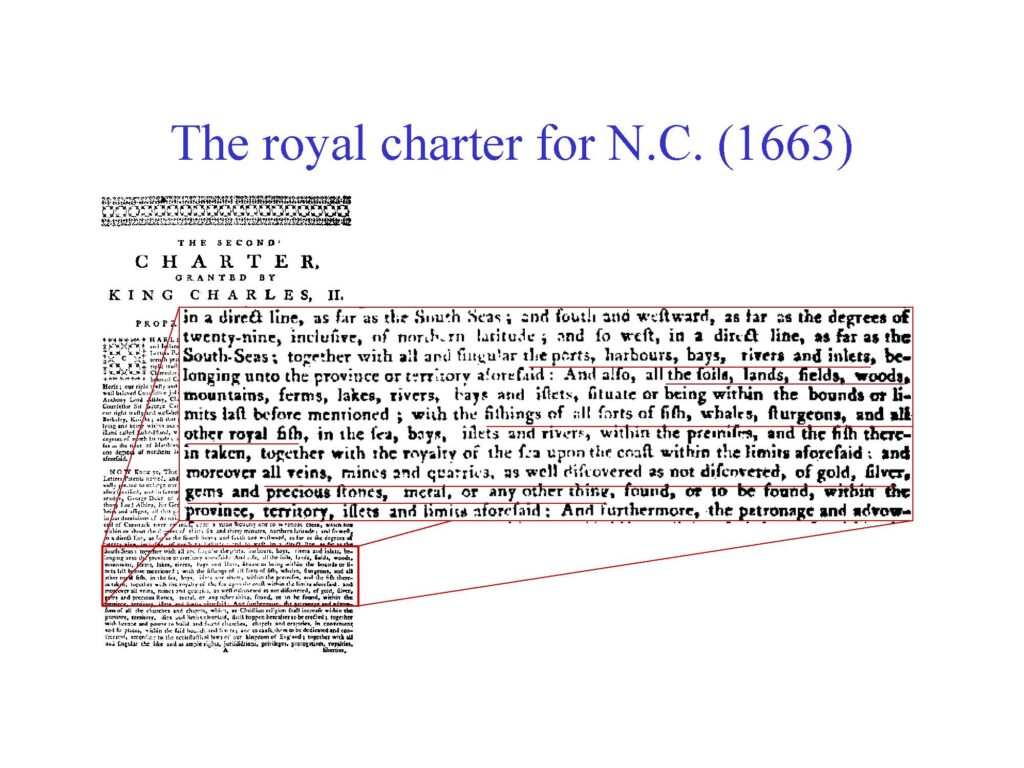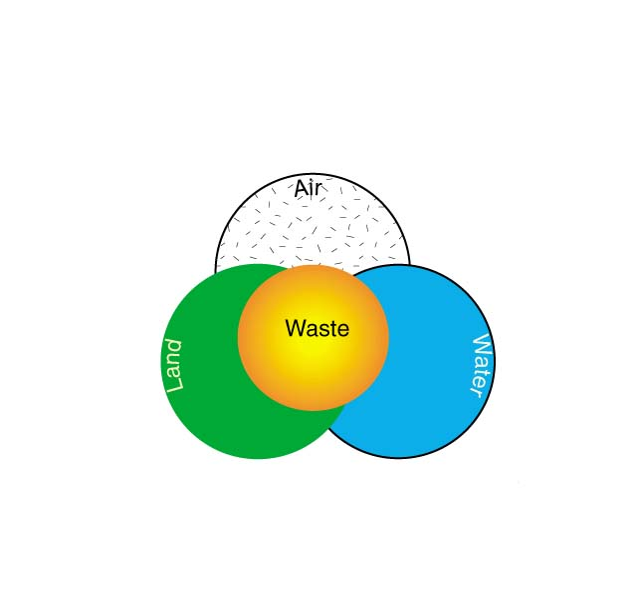Some fields of law have fairly clear boundaries. Not so with environmental law. In order to say anything with the least bit of clarity about the field of environmental law as such, you need some sense of what does and doesn’t count as part of the field. I have a simple model of what counts, for my own purposes. In this entry, I will explain my model of the field, and also talk about some of the limitations and unresolved boundary issues with my model. It starts with a recognition that law has long been concerned with two related things, natural resources and waste.
By “natural resources,” I mean primarily:
- waters
- fish
- forests
- fields/farms
- minerals
These are things that have been recognized since time immemorial as vital to the lives of humans. They were vital to our Neolithic ancestors. They will be as or more vital to our Anthropocene descendants. The law in North Carolina has been concerned with them at least since colonial days (I am not a scholar of Native American culture, so I won’t try to comment on native institutions to regulate natural resource extraction and use, but I have no doubt there were important such institutions that could be deemed “law”). In fact, these resource categories are front and center in the royal charter granting the Carolinas to the Lords Proprietors in 1663:

Waters, fish, woods, fields, minerals: these were the things the king granted, along with the land, to reward his supporters in the Restoration of 1660 (Elizabeth I’s earlier grants to Sir Walter Raleigh failed to yield a permanent colony in the Carolinas, though famously producing a “Lost Colony,” thus helping to ensure that North Carolina would become the “vale of humility between two mountains of conceit“).
So this is one important part of the field of environmental law: the rights and responsibilities related to natural resources. To me, this includes not just rights and responsibilities concerning the extraction of these resources, but also limitations on their use and even some aspects of their delivery to consumers. For example, I consider the laws relating to drinking water treatment and distribution to be, in part, environmental laws, though at this point in the model there appears another important field, public health law, with a fuzzy boundary between it and environmental law. You see the fuzziness of this boundary in the historically tortuous and disputed efforts to locate the State environmental health bureaucracy either within the Department of Environment and Natural Resources or the Department of Health and Human Services–or within both, as was done for several years in the late 1990s and early 2000s.
The second major part, in my simple model, concerns the waste that is inevitably produced by the extraction and use of natural resources. Governmental concern about waste, and laws about waste, also stretch far back in time. But there was a major eruption of federal environmental statutes in the 1970s and 1980s, directly focused on waste–or “pollution” as it’s commonly called when released into the environment–and that handful of statutes, along with their state counterparts, has been so important in the last three decades that it is equated with “environmental law” for many. I give it separate representation in my model because of the importance of these statutes–at the federal level, the Clean Air Act, Clean Water Act, Resource Conservation and Recovery Act and Comprehensive Environmental Response, Compensation and Liability Act, and at the state level, analogues to each of these.

I put waste at the center of air, water and land to emphasize an important fact: once we create waste, if we don’t reuse it somehow, it never really goes “away.” It goes into the air, or into the water, or into the land. From there it might move among these three spheres, and it might change form chemically. It might even return to become a part of us physically, by moving into the food chain. But “throw it away” is a phrase that connotes a narrow view of the world, like an infant’s, where things not in our immediate perceptual field are assumed not to exist. The enormous volumes of waste that humans in the developed world create stay in that world and represent real costs to manage.
A note about the term “waste” itself”: it has a famously broad legal definition (“solid waste” means pretty much anything abandoned or discarded, whether in solid, liquid or gaseous form, with a wide assortment of exceptions and exemptions that reflect political realities–See N.C. Gen. Stat. 130A-290, similar but not identical to the federal definition at 42 U.S.C. § 6903). Yet my usage is even broader: by “waste” I mean anything produced by human activity that is not necessary to the purpose for which it was produced and that isn’t reclaimed or recycled before being released into the environment. So, for example, my usage includes light and noise pollution, which are both forms of energy we produce unnecessarily.
Laws about natural resources and waste form the core of environmental law, to me. I doubt there is much argument or uncertainty about this, at least at this level of abstraction. But as one moves into other aspects of environmental law, one bumps up against other fields, and there is no precise boundary between them. I have already mentioned the important connection with public health law. Other critical boundaries are:
- planning and land use (where environmental consequences may or may not be considered)
- the general law of governmental decision making and policy analysis (consider the National and State Environmental Policy Acts)
- energy (increasingly affected by considerations about waste, including greenhouse gases)
- real estate (with land conservation having become an important part of environmental protection)
- food (I listed fields/farms as one of the core, original concerns, but beyond the production side of agriculture and its environmental consequences, the general questions of food policy and food safety have increasingly important environmental aspects)
- education (a movement to promote environmental education importantly connects with debates over education law and policy in general)
- administrative law (environmental issues and conflicts have been a huge driver of developments in state and federal administrative law)
In sum, I start with a core of laws about natural resources and waste handling, and move out to a periphery that includes the seven critical and contested boundaries noted above. That is my simple model of environmental law: fuzzy at the boundaries, but inherently important to human activity, and not just because of the major pollution concerns that arose in public consciousness in the 1970s and 1980s.
This model helps me keep some of the legal and bureaucratic boundaries we have erected straight in my mind, but I hasten to add that a lot of insights in the field have and will keep coming from ignoring these boundaries and instead considering the relationships between them. For example, considering the ways that forests and water resources influence each other, perhaps with the help of fish and their waste, as shown in research on salmon and their role in the nitrogen cycles of arboreal forests.
The bigger picture–the really important context–is the picture that ecology and other interdisciplinary science give us of the world and the role of humans in that world. Environmental law is an ongoing attempt to keep human activity from creating too many problems, and it necessarily needs to evolve with our understanding of the way the world works. In light of this great and fundamental purpose, our models of environmental law will always be simple and incomplete. Hopefully they at least can help keep track of the complicated legal structures we have created.

2 Responses to “What is environmental law? on fuzzy boundaries”
Scott Johnson
My brother-in-law is currently attending law school and is looking at transferring over to environmental law, so I’ve been doing a little bit of research on it to help him out. I didn’t know that environmental law focused primarily on natural resources and wast, although I am sure there are hundreds of smaller categories under each one. I really like how you lay out what environmental law is in layman’s terms and it is a good message. I’m definitely going to talk with my brother-in-law about this, it might really be what he should do with his degree. http://www.msbtlaw.com/PracticeAreas.aspx
Scott Johnson
My brother-in-law is currently attending law school and is looking at transferring over to environmental law, so I’ve been doing a little bit of research on it to help him out. I didn’t know that environmental law focused primarily on natural resources and wast, although I am sure there are hundreds of smaller categories under each one. I really like how you lay out what environmental law is in layman’s terms and it is a good message. I’m definitely going to talk with my brother-in-law about this, it might really be what he should do with his degree. http://www.msbtlaw.com/PracticeAreas.aspx